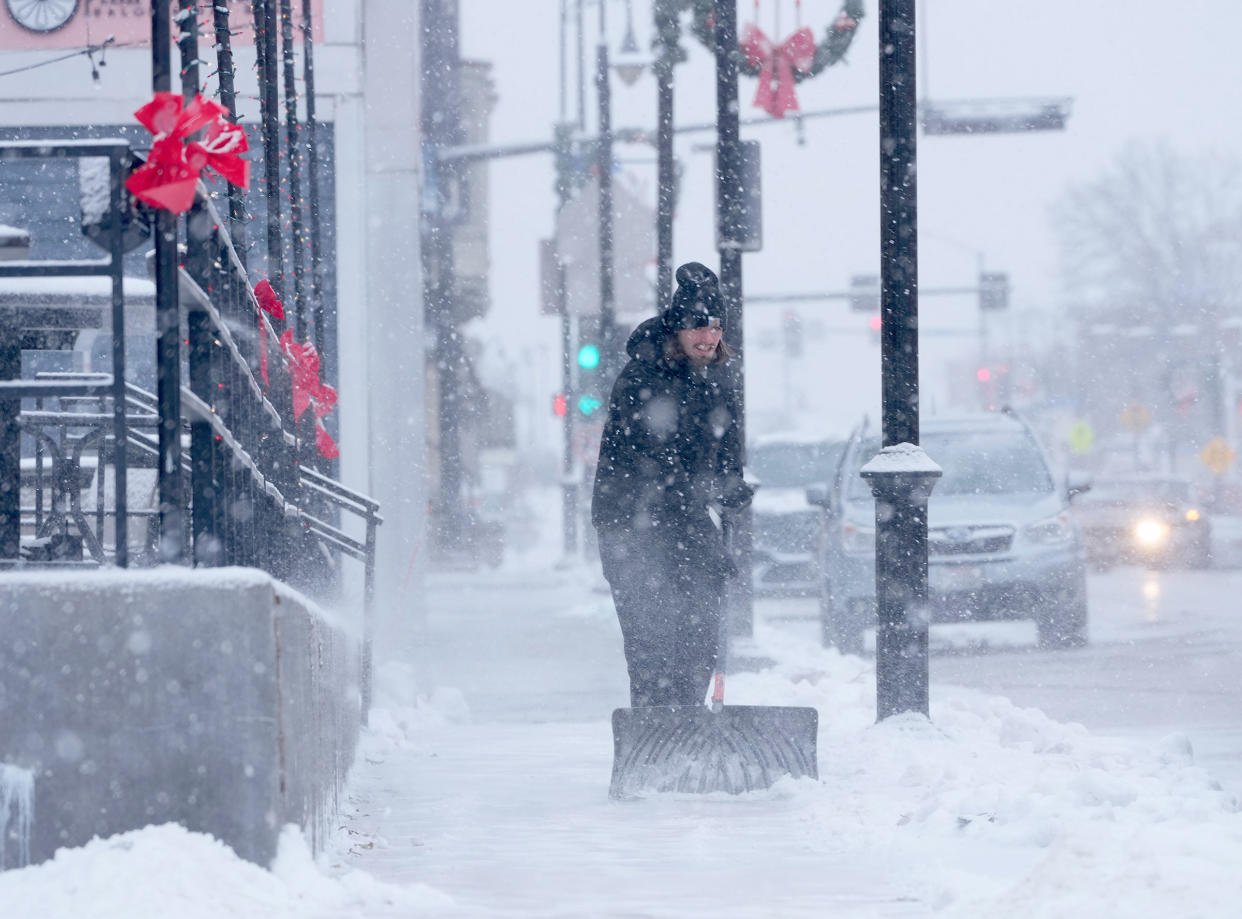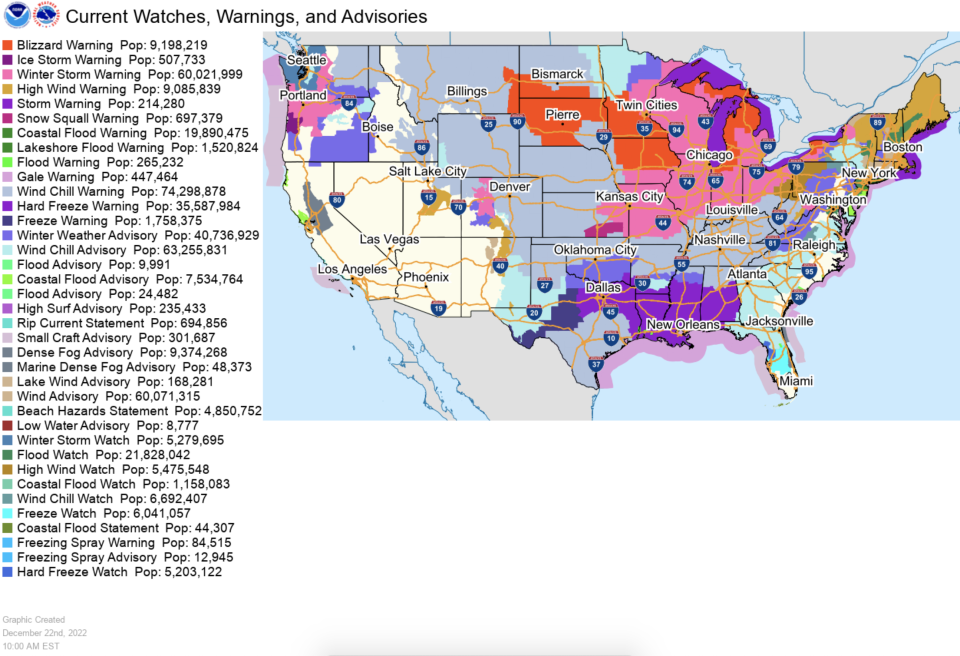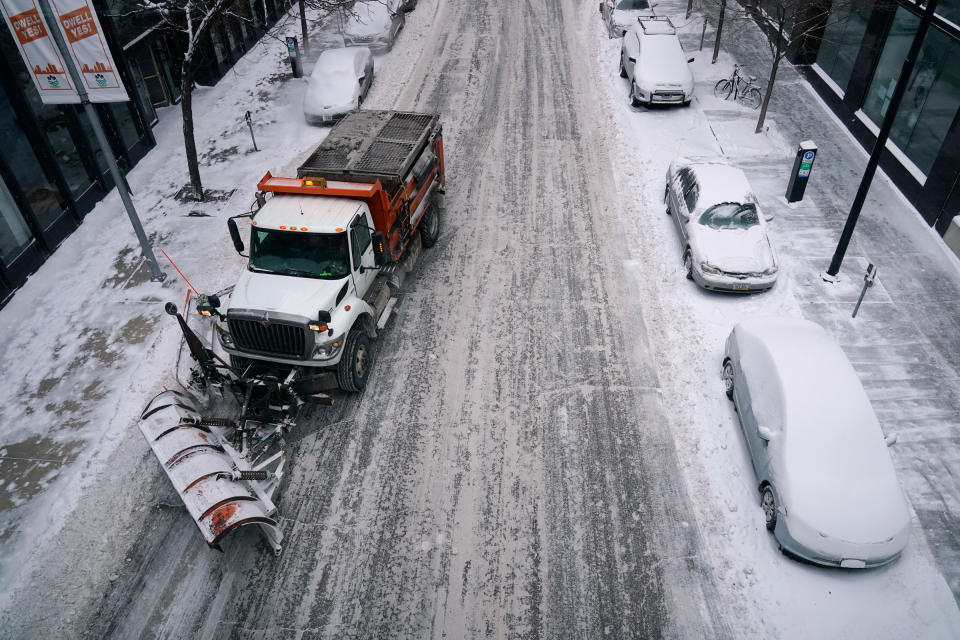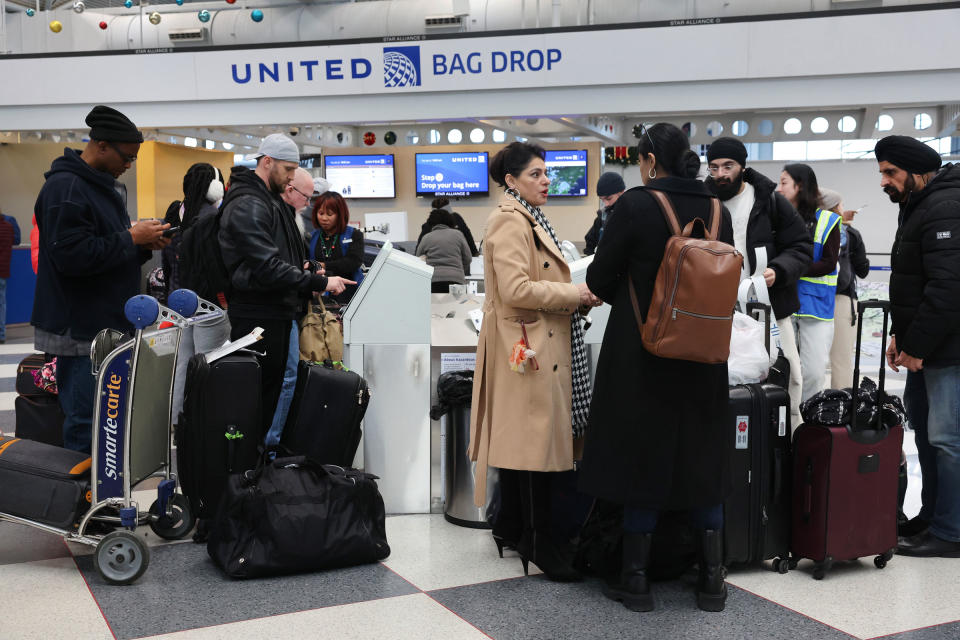A Deadly Bomb Cyclone Could Hit More Than 200 Million People by Christmas. Here’s What to Know

- Oops!Something went wrong.Please try again later.
Carson Batchelor, a server at the Hot House Tavern, shovels snow from the sidewalk in front of the business in Menomonee Falls, Wis., on Dec. 22, 2022. Credit - Mike De Sisti—Milwaukee Journal-Sentinel/AP
A massive winter storm that could bring “life-threatening” conditions is sweeping across the U.S. this week, threatening to affect travel for millions of Americans ahead of the holidays. Bitter cold temperatures are already being recorded across the midwest, great plains and south—hitting -16 degrees in Montana— and with six inches of snow already falling around the Great Lakes. Airports in Chicago and Denver are seeing severe delays with almost 1,700 flights canceled nationally as of Thursday morning
Over 65 million people nationwide are under winter storm advisories, watches and warnings and more than 135 million face wind chill alerts. President Biden is meeting with the National Weather Service and FEMA officials and is encouraging Americans to “take this storm extremely seriously.”
“This is not like a snow day when you were a kid,” Biden said Thursday morning in the Oval Office. “This is serious stuff.”

The storm picked up on Wednesday night and quickly intensified by Thursday. It’s expected to peak on Friday with snowstorms in the Great Lake states and high winds along much of the east coast. The Great Lakes region will likely bear the brunt of the storm, but meteorologists are also keeping a close eye on Texas, where the forecast predicts an icy windchill.
Minnesota meteorologist Sven Sundgaard advises locals to continue checking the latest weather forecasts ahead of travel plans. “It’s one thing to travel during a snowstorm that’s already treacherous, but then you add in these extreme wind chills and cold air and it can really become a dangerous situation,” he says.
Sundgaard’s sister is no exception to his advice. She had planned to travel on Friday from Milwaukee to the Twin Cities with her husband and two children, but will now most likely delay their five hour drive to Christmas Eve to avoid the height of the storm.
Here’s what to know:
More from TIME
Who’s likely to be affected?
The storm began moving through the Northwest on Monday night, bringing snow to Washington, more than a foot in the Olympic and Cascade Mountain regions. By early Thursday morning, the storm will likely move to the Midwest, where it’s expected to cause 6-12 inches of snowfall. Snow is expected to pile up on highways in the region, so officials are advising against driving. Public transportation will also likely suffer from snow and ice.
Parts of the East coast could experience record-low colds and will likely get some freezing rain. “When you get to the Southeast along the East coast, at least initially, it’s gonna get pretty warm. There’s going to be some rain, gusty winds and maybe even some thunderstorms, but by the time we get to Friday night, it’s going to get real cold,” John Grushiak, a senior meteorologist at Accuweather, tells TIME.
High winds that threaten to knock over trees could cause hundreds of thousands of power outages, particularly in Michigan, Indiana, Ohio, Pennsylvania and New York.

Weather officials assured Texans that although this year’s storm will bring freezing temperatures to cities like Houston and Austin, it won’t be as long or snowy as the weeklong storm in Feb. 2021 that resulted in massive power grid failure.
“When it gets really cold down there, they have problems with the electrical grid, and people trying to heat their homes, demanding more and more electricity,” Grushiak says. The Electric Reliability Council of Texas has said that it has upgraded since the last storm and “expects sufficient generation to meet forecasted demand.”
As of Wednesday, the National Weather Service had weather advisories and storm watches in effect in every state except for South Carolina, Nevada and Arizona.
Where will the storm be the worst?
So far, Oklahoma has declared a state of emergency under hazardous road conditions, Louisiana’s governor is asking residents to prepare for life-threatening temperatures, Arkansas is anticipating flash-freezing today and Pierre Regional Airport in South Dakota’s capital has closed due to the weather.
In the Midwest, particularly by the Great Lakes, the snow combined with high winds will bring blizzard-like conditions. Fueled by extreme cold in the Northern plains and pushed by an arctic cold front, weather conditions are subject to change rapidly. If the storm gains enough strength quickly and its barometric pressure drops enough, it’ll qualify as a “bomb cyclone,” which rarely occurs on land.
“One of the big things about the storm and following it is going to be the cold,” Grushiak says. “It’s going to be one of the coldest Christmases that has ever occurred in a lot of places.”
In the Dakotas, Montana and Minnesota, wind chill may be around negative 40 degrees Fahrenheit and Wyoming’s wind chill could be as low as negative 70 degrees Fahrenheit. Denver could have its coldest day in 32 years, if the temperature reaches negative 14 degrees Fahrenheit on Friday like forecasters predict.
Some communities, including Portland, Oregon, Buffalo, New York and Cincinnati, Ohio, are opening up warming centers—short-term, emergency shelters for unhoused people to spend the storm in.
By Saturday, the storm will likely pass into eastern Canada but its impact may continue through Christmas day with more snow and wind. Wind chill will make the cold feel even stronger and severe wind chill can cause frostbite in as little as five minutes, according to the National Weather Service.
Travel amid the storm

Weather conditions of this magnitude will require adjusting travel plans as necessary. Jalyn Souchek, a PR manager for Memphis Tourism, was expecting to drive eight hours north on Thursday to Cedar Rapids, Iowa to see her family, but she made arrangements with her job to leave a day early to ensure her safety.
On Thursday alone, over 2,800 flights were delayed in the U.S. and over 1,700 were canceled, according to FlightAware. Kareem George, a travel advisor for Culture Traveler, tells TIME that safety comes first while traveling through such conditions, but there are a few ways travelers can prepare for the inevitable delays.
“We always advise our travelers to purchase travel insurance. Depending on the travel insurance policy that a client may have, there are provisions for delays where funds can be allocated to cover additional costs for penalties or for hotels or various different costs that are associated with having to reschedule,” George says.
He explains that travel insurance can make the ordeal a lot easier, at least in terms of being reimbursed. George emphasizes the need to save your receipts and document delays, which is useful even for those without travel insurance, in case transportation companies offer refunds. Many major airlines—including United Airlines, Southwest Airlines, American Airlines, Jetblue and Spirit Airlines—have already begun issuing waivers that allow travelers to change their itineraries ahead of the storm.
Travel blogger Andrea Litwa, who lives in Carmel, Indiana, advises flexibility for a safer travel experience, even if it means changing or canceling your flight or driving arrangements for after the holidays, into January. “It’s so stressful when things don’t go as planned, but if you can get ahead of it, set your expectations, and know that you may have to pivot, that will help,” she says.
Nearly three million people are expected to travel for the holidays through Chicago, a busy airport hub. “In a major city like Chicago, there are several hotels that are within shuttle ride [distance],” George says. He suggests researching accommodation options beforehand or staying in touch with friends and family nearby in case you have a lengthy delay.
“Traveling carry-on only is something I often recommend whenever that’s possible,” George says. “You can have all of your appropriate items with you, whether that be medications or just toiletries and clothes, so you can be as comfortable as possible if you’re going to have to stay longer than anticipated in the airport.”

